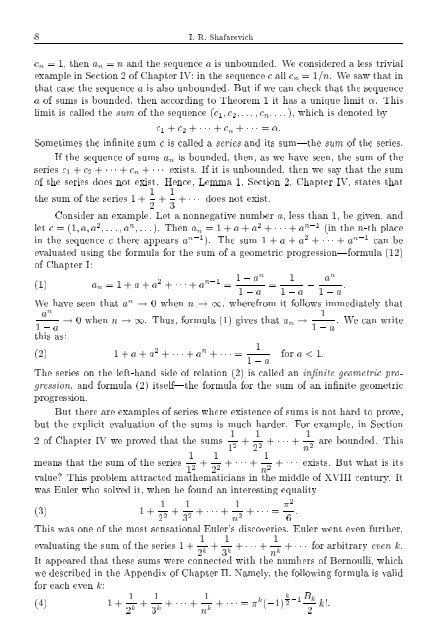8 I. R. <strong>Shafarevich</strong>c n =1,thena n = n and the sequence a is unbounded. We considered a less trivialexample in Section 2 of Chapter IV: in the sequence c all c n =1=n. We sawthatinthat case the sequence a is also unbounded. But if we cancheck that the sequencea of sums is bounded, then according to Theorem 1 it has a unique limit . Thislimit is called the sum of the sequence (c 1 c 2 ...c n ...), which is denoted byc 1 + c 2 + + c n + = :Sometimes the innite sum c is called a series and its sum|the sum of the series.If the sequence of sums a n is bounded, then, as we have seen, the sum of theseries c 1 + c 2 + + c n + exists. If it is unbounded, then we say that the sumof the series does not exist. Hence, Lemma 1, Section 2, Chapter IV, states thatthe sum of the series 1 + 1 2 + 1 + does not exist.3Consider an example. Let a nonnegative number a, lessthan1,begiven, andlet c =(1aa 2 ...a n ...). Then a n =1+a + a 2 + + a n;1 (in the n-th placein the sequence c there appears a n;1 ). The sum 1+a + a 2 + + a n;1 can beevaluated using the formula for the sum of a geometric progression|formula (12)of Chapter I:(1) a n =1+a + a 2 + + a n;1 = 1 ; an1 ; a = 11 ; a ; an1 ; a :We have seenthata n ! 0whenn !1, wherefrom it follows immediately thata n1 ; a ! 0 when n !1. Thus, formula (1) gives that a n ! 1 . We can write1 ; athis as:(2) 1+a + a 2 + + a n + = 1 for a
Selected chapters from algebra 9We know nearly nothing about analogous sums with odd k. It was proved onlyrecently (in 1978) that the sum 1+ 1 2 + 1 3 3 ++ 1 + is an irrational number.3 n3 This remains probably the only known fact about these sums for odd values of k.Let us remark that just knowing the fact that a series c 1 + c 2 + + c n + has a sum, one can deduce useful corollaries even if the value of the sum is notknown.LEMMA 3. If the sum of the series c 1 + c 2 + + c n + exists, then thesequence of numbers d n = c n + c n+1 + unboundedly approaches 0.We shall use an easy property ofthe limit. Suppose that a sequence a 1 , a 2 ,... , a n ,... has a limit , i.e., a n ! when n !1. Then for each number thesequence ; a 1 , ; a 2 ,..., ; a n ,... has the limit ; . Really, the dierence ;;( ;a n )=a n ;, and the dierence a n ; ! 0, hence ;;( ;a n ) ! 0when n !1. Denote the sum of the series c 1 + c 2 + + c n + by and thenumber c 1 + c 2 + + c m by a m . By the denition of the sum of an innite series,the sum of the series c 1 + c 2 + + c n + is equal to the limit of the sequencea 1 , a 2 ,... ,a m ,... . In the same way the sum d n of the sequence c n+1 +c n+2 +is equal to the limit of the sequence a n+1 ; a n , a n+2 ; a n , ... a n+k ; a n , ... . Bythe remark from the beginning of the proof, the last limit is equal to 0 ; a n ,where 0 is the limit of the sequence a n+1 , a n+2 , ... , a n+k , ... (for xed n). But thelimit of the sequence a n+1 , a n+2 , ... is the same as the limit of the sequence a 1 ,a 2 , . . . , i.e., 0 = . We obtain that d n = ; a n . But, by the denition of limit, ; a n ! 0, i.e., d n ! 0whenn !1.As an example, put d n = 1 n + 12 (n +1) + . We see that d 2 n ! 0 whenn !1.Considering limits of innite sums leads us away from algebra, which is mainlyconcerned with nite expressions. These questions are closely related with anotherbranch of mathematics, called analysis. That is why we are not going to considerthem in more detail. Let us remark only that the most interesting results|such asformulas (3) and (4)|appear on borders of these areas.Problems1. Prove that if the sum of the series c 1 +c 2 ++c n + exists, then c n ! 0when n !1.2. Prove that if a n
















